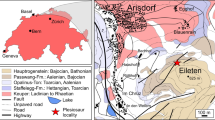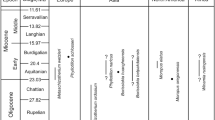Abstract
A mandibular specimen from the Bolivian Early Oligocene is provisionally assigned toBranisella boliviana. The crown anatomy of the single preserved tooth, an M2, indicates platyrrhine affinities and several details of the broken jaw are suggestive of symphyseal fusion. Like the African Oligocene parapithecids,Branisella contrasts with extant anthropoids in the relative shallowness of its mandible.Branisella is the most ancient, and seemingly the most primitive, fossil platyrrhine monkey, lacking any of the derived features of the two major clades of modern ceboids. Taxonomically, it is best regarded as family incertae sedis.
Similar content being viewed by others
References
Ba Maw, T. T., Cicohon, R. L., and Savage, D. E. (1979). Late Eocente of Burma yields earliest anthropoid primate,Pondaungia cotteri.Nature 282: 65–67.
Beecher, R. M. (1977). Function and fusion at the mandibuiar symphysis.Am. J. Phys. Anthropol. 47: 324–336.
Gingerich, P. D., and Simons, E. L. (1977). Systematics, phylogeny and evolution of earliest Eocene Adapidae (Mammalia, Primates) in North America.Contrib. Mus. Paleontol. Univ. Mich. 24: 245–279.
Hershkovitz, P. (1977).Living New World Monkeys (Platyrrhini) with an Introduction to Primates, Vol. 1, University of Chicago Press, Chicago.
Hoffstetter, R. (1969). Un primate de l’oligocene inférieur sud-Américan:Branisella boliviano gen. et sp. nov.C. R. Acad. Sci. (Paris) 269: 434–437.
Hylander, W. L. (1979). The functional significance of primate mandibular form.J. Morphol. 160: 223–240.
Kay, R. F. (1981). Platyrrhine origins: A critical reappraisal of the dental evidence. In Ciochon, R. L., and Chiarelli, A. B. (eds.),Evolutionary Biology of New World Monkeys and Continental Drift, Plenum Press, New York (in press).
Kay, R. F., Fleagle, J. G., and Simmons, E. L. (1981). A revision of the Oligocene apes of the Fayum Province, Egypt.Am. J. Phys. Anthropol. 55: 293–322.
Kinzey, W. G. (1973). Reduction of the cingulum in Ceboidea. In Zingeser, M. R. (.),Craniofacial Biology of Primates, S. Karger, Basel, pp. 101–127.
Rosenberger, A. L. (1978). New data onBranisella andHomunculus.Am. J. Phys. Anthropol. 48: 431.
Rosenberger, A. L. (1979).Phylogeny, Evolution and Classification of New World Monkeys (Platyrrhini, Primates), Unpublished dissertation, City University of New York, New York.
Simons, E. L. (1972).Primate Evolution: An Introduction to Man’s Place in Nature, Macmillan, New York.
Szalay, F. S. (1976). Systematics of the Omomyidae (Tarsiiformes, Primates): Taxonomy, phylogeny and adaptations.Bull. Am. Mus. Nat. Hist. 156: 157–450.
Szalay, F. S., and Delson, E. (1979).Evolutionary History of Primates, Academic Press, New York.
Author information
Authors and Affiliations
Additional information
An erratum to this article is available at http://dx.doi.org/10.1007/BF02693750.
Rights and permissions
About this article
Cite this article
Rosenberger, A.L. A mandible ofBranisella boliviana (Platyrrhini, Primates) from the oligocene of South America. Int J Primatol 2, 1–7 (1981). https://doi.org/10.1007/BF02692295
Received:
Issue Date:
DOI: https://doi.org/10.1007/BF02692295




